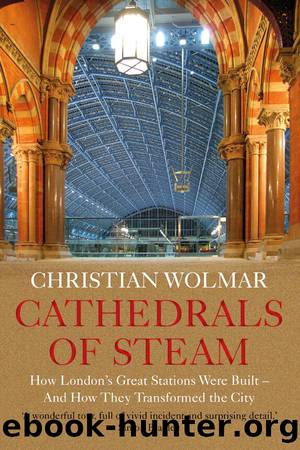Cathedrals of Steam by Christian Wolmar

Author:Christian Wolmar
Language: eng
Format: epub
Publisher: Atlantic Books
NINE
THE WORKERSâ STATION
THE RAILWAYS SERVING the East of England were an impoverished group, not least because the region was poor railway territory mostly given over to agriculture with a low population density. The potential for attracting Londoners to make shorter train journeys had been neglected by the rival companies and they struggled to establish successful markets for longer journeys. The biggest of these companies, the perennially cash-strapped Eastern Counties, had a terrible reputation for poor punctuality and delay. W.M. Acworth, who wrote an amusing history of the railways, called it the âpariah of companiesâ. He related how âa strapping 16 year-oldâ had been refused a childâs half-price ticket by an inspector only to insist âthat he was under twelve when the train startedâ, and Acworth went on to misquote Thackeray: âeven a journey on the Eastern Counties must have an end at lastâ.1
Even though the north-eastern suburbs were already more extensive than those in other parts of the capital, the Eastern Counties Railway had ignored this potential market for short-distance travel through a policy of running infrequent services combined with high fares. It was, therefore, little surprise that the Board of Trade, which was generally reluctant to allow mergers of large railway companies, broke with normal practice to wave through the plans to create the Great Eastern even in the face of a wide range of objectors concerned about giving too much regional power to a particular railway company. The main component of the new company was the Eastern Counties but it also included four other sizeable railways and a number of their subsidiaries and associated companies, which did indeed result in the creation of a regional monopoly, an unusual feature at the time.
The decision to build a large station on the edge of the City was predicated on a change of attitude. The Great Eastern would now focus on the commuter market as a route to prosperity. As we saw in Chapter 5, Bishopsgate was an inconvenient terminus, both poorly located and too small, but despite various attempts in the 1850s to find another site, the poor financial state of the Eastern Counties and concern from City interests stood in the way of progress.
That changed quickly once the amalgamation went through in 1862 and the directors examined potential sites for the new station. While the Great Eastern had also taken over a few services that ran into Fenchurch Street, there was no potential for expanding this little terminus nestled in a far-off corner of the City, and negotiations with the North London Railway to make use of Broad Street got nowhere. Finsbury Circus was briefly considered as a possible terminus, as was a site in Wormwood Street, a couple of hundred yards south of the present Liverpool Street station, but both were rejected as impractical.
The only feasible site was on the east side of the North Londonâs terminus at Broad Street, which meant that once again the capital was about to get two adjoining stations run by separate companies and operating to a different set of destinations without any coordination.
Download
This site does not store any files on its server. We only index and link to content provided by other sites. Please contact the content providers to delete copyright contents if any and email us, we'll remove relevant links or contents immediately.
| Africa | Americas |
| Arctic & Antarctica | Asia |
| Australia & Oceania | Europe |
| Middle East | Russia |
| United States | World |
| Ancient Civilizations | Military |
| Historical Study & Educational Resources |
The Third Pole by Mark Synnott(914)
Money for Nothing by Thomas Levenson(898)
The Economist (20210109) by calibre(897)
Christian Ethics by Wilkens Steve;(824)
Made in China by Anna Qu(812)
The Age of Louis XIV: The Story of Civilization by Will Durant(788)
Reopening Muslim Minds by Mustafa Akyol(768)
Nonstate Warfare by Stephen Biddle(766)
100 Posters That Changed The World by Salter Colin T.;(750)
Culture by Terry Eagleton(723)
The Shortest History of China by Linda Jaivin(721)
The Great Pyramid Void Enigma by Scott Creighton(721)
The Irish Buddhist by Alicia Turner(716)
Ideology by Eagleton Terry;(696)
Routledge Handbook of Contemporary India by Knut A. Jacobsen(694)
Sybille Bedford by Selina Hastings(656)
The Jews of Silence: A Personal Report on Soviet Jewry by Elie Wiesel(650)
Objects of Vision by Saab A. Joan;(639)
Banaras: CITY OF LIGHT by Diana L. Eck(631)
